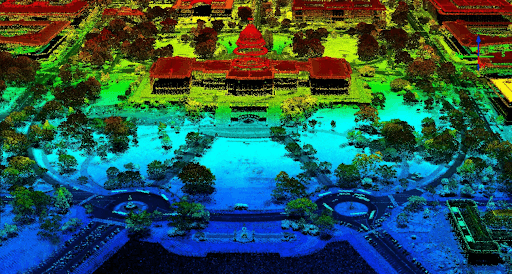Believe it or not, one of the most important pieces of modern technology isn’t all that new.
The tech world is full of examples like this. Inventing a new device from the comfort of a laboratory is one thing, but it often takes years before that same tech finds its way to commercial success.
Does this image look familiar?

Unless you’re a high-level tech geek, I wouldn’t expect you to get it right off the bat. The object in question is one of the earliest prototypes of a laser, first invented in 1960 by the Hughes Aircraft Company.
The race to harness the power of light was brutal. Bell Telephone Laboratories, one of the biggest scientific facilities on Earth at the time, was also committed to unlocking the secret first. 
At first, executives at Hughes were skeptical. After all, what did an aerospace company need with a beam of light?
Luckily, that skepticism didn’t get in the way of one of the most important physics discoveries in history. In less than 10 years, lasers went from a scientific curiosity to a household tool.
The public’s first introduction to lasers came in the form of barcode scanners. A tightly controlled beam of light would bounce off the reflective white portions and provide information in an instant.
Aside from science-fiction weaponry, bouncing lasers off of things and then deciphering the reflections is pretty much the extent of our uses for them. High-powered units can be used for welding and cutting, but scanning and reading data is currently their chief role.
It sounds mundane, but sometimes the boring applications are the most important.
Lasers are already found in a few common household items, but pretty soon they’re going to be everywhere. You won’t be able to walk down the street without being bombarded by a laser in some way.
Now, don’t panic. For now, the public is safe from being vaporized like an enemy of the Death Star.
These lasers will be invisible and so low-power than you won’t even see them. But in a way, they will see you.
Let me explain…
Our analysts have traveled the world over, dedicated to finding the best and most profitable investments in the global energy markets. All you have to do to join our Energy and Capital investment community is sign up for the daily newsletter below.
The Eyes Are Watching
Lasers are just a concentrated ray of light that is directed in a one consistent direction. Unlike the scattered light from the sun, a laser goes exactly where you point it.
Since it’s headed in one direction, lasers will also bounce off a target in a predictable direction. This predictability makes barcode scanners and DVD readers possible.
In a way, the newest evolution of laser technology is no different than its predecessors. It’s just another example of us firing lasers at an object and then reading the reflections.
The only difference? The “barcode” you’re reading is 100 feet away, and your “scanner” is traveling at 60 miles an hour — with you inside it.
The next big leap in laser tech is called LIDAR, and although I call it “new,” this concept is practically as old as lasers themselves. We can credit the founding fathers of lasers themselves, the Hughes Aircraft Company, for this invention. The very same team that designed the first laser in 1960 also created the first LIDAR prototype a few years later.
If you’re new to the concept, LIDAR is shockingly simple. It stands for Light Detection and Ranging, just like radar stands for Radio Detection and Ranging. Instead of radio waves, LIDAR units use laser pulses to identify distant objects.
Unlike radar, LIDAR is incredibly fast and accurate down to the millimeter. It’s accurate enough to detect the tiniest variations in distance and size, returning images that display a huge amount of detail in a fraction of a second.

The technology itself is improving every day. At first, the best LIDAR unit on the market could barely discern a person walking through an empty room.
Now, a drone equipped with a downward-facing LIDAR can map hundreds of miles of terrain with pinpoint accuracy. In fact, the recent unveiling of this laser-scanning technology has already revealed long-lost Mayan ruins deep in the jungle.
Uncovering the secrets of the past is great, but it’s far from being a life-changing discovery — unless you’re a long-lost Mayan, that is.
No, the facet of LIDAR that will change the world is its ability to give computers the power of sight. Currently, the most lucrative application of LIDAR is autonomous vehicles.
As someone who has driven their entire life, skepticism about turning over the keys to a computer is 100% understandable.
A computer glitch is a minor annoyance, but when that computer is hurtling you through the streets at 70 miles per hour, that same glitch becomes a catastrophe.
But the computers powering these vehicles are not the same as your low-end desktop from the early 2000s. Combined with LIDAR units, these computers will be much faster and more accurate than even the best human driver.
Once the technology becomes foolproof — and believe me, it will happen soon — I wouldn’t be surprised to see human driving become illegal. It sounds like an exaggeration, but it’s a very real possibility.
The profit potential for this technology is incalculable. Once every car on the planet becomes autonomous, the world will be filled with lasers.
Tesla is responsible for a similar automotive revolution but with electric vehicles instead of autonomous ones.

Take a look at its share prices. That’s just a fraction of the potential LIDAR has.
Don’t believe me? Take it directly from the expert. Angel Publishing’s senior tech analyst, Keith Kohl, has compiled all the information you need to stay ahead of the bandwagon.
Check out his free presentation on LIDAR investment here, no registration required.
To your wealth, Luke Sweeney Luke’s technical know-how combined with an insatiable scientific curiosity has helped uncover some of our most promising leads in the tech sector. He has a knack for breaking down complicated scientific concepts into an easy-to-digest format, while still keeping a sharp focus on the core information. His role at Angel is simple: transform piles of obscure data into profitable investment leads. When following our recommendations, rest assured that a truly exhaustive amount of research goes on behind the scenes..
Contributor, Energy and Capital

